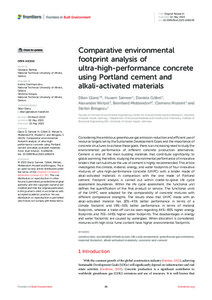| dc.date.accessioned | 2023-06-13T11:55:15Z | |
| dc.date.available | 2023-06-13T11:55:15Z | |
| dc.date.issued | 2023-05-22 | |
| dc.identifier | doi:10.17170/kobra-202306138210 | |
| dc.identifier.uri | http://hdl.handle.net/123456789/14815 | |
| dc.description.sponsorship | Gefördert durch den Publikationsfonds der Universität Kassel | |
| dc.language.iso | eng | |
| dc.rights | Namensnennung 4.0 International | * |
| dc.rights.uri | http://creativecommons.org/licenses/by/4.0/ | * |
| dc.subject.ddc | 620 | |
| dc.title | Comparative environmental footprint analysis of ultra-high-performance concrete using Portland cement and alkali-activated materials | eng |
| dc.type | Aufsatz | |
| dcterms.abstract | Considering the ambitious greenhouse gas emission reduction and efficient use of resource targets set by the Sustainable Development Goals and the importance of concrete structures to achieve these goals, there is an increasing need to study the environmental performance of different concrete production alternatives. Cement is one of the main building materials that contribute significantly to global warming; therefore, studying the environmental performance of innovative binders that can substitute the use of cement is highly recommended. This article investigates the climate, material, energy, and water footprints of four innovative mixtures of ultra-high-performance concrete (UHPC) with a binder made of alkali-activated materials in comparison with the one made of Portland cement. Footprint analysis is carried out within cradle-to-grave life cycle assessment boundaries. Within the life cycle assessment, the functional unit defines the quantification of the final product or service. The functional units of the UHPC were adapted for the comparability of concrete mixtures with different compressive strengths. The results show that UHPC made with an alkali-activated material has 32%–45% better performance in terms of a climate footprint and 19%–33% better performance in terms of material footprints, whereas a trade-off can be seen regarding 44%–83% higher energy footprints and 75%–146% higher water footprints. The disadvantages in energy and water footprints are caused by waterglass. When allocation is considered, mixtures with high silica fume content have higher environmental footprints. | eng |
| dcterms.accessRights | open access | |
| dcterms.creator | Glanz, Dilan | |
| dcterms.creator | Sameer, Husam | |
| dcterms.creator | Göbel, Daniela | |
| dcterms.creator | Wetzel, Alexander | |
| dcterms.creator | Middendorf, Bernhard | |
| dcterms.creator | Mostert, Clemens | |
| dcterms.creator | Bringezu, Stefan | |
| dcterms.extent | 11 Seiten | |
| dc.relation.doi | doi:10.3389/fbuil.2023.1196246 | |
| dc.subject.swd | Portlandzement | ger |
| dc.subject.swd | Ökologischer Fußabdruck | ger |
| dc.subject.swd | Ultrahochfester Beton | ger |
| dc.type.version | publishedVersion | |
| dcterms.source.identifier | eissn:2297-3362 | |
| dcterms.source.journal | Frontiers in Built Environment | eng |
| dcterms.source.volume | Volume 9 | |
| kup.iskup | false | |
| dcterms.source.articlenumber | 1196246 | |


